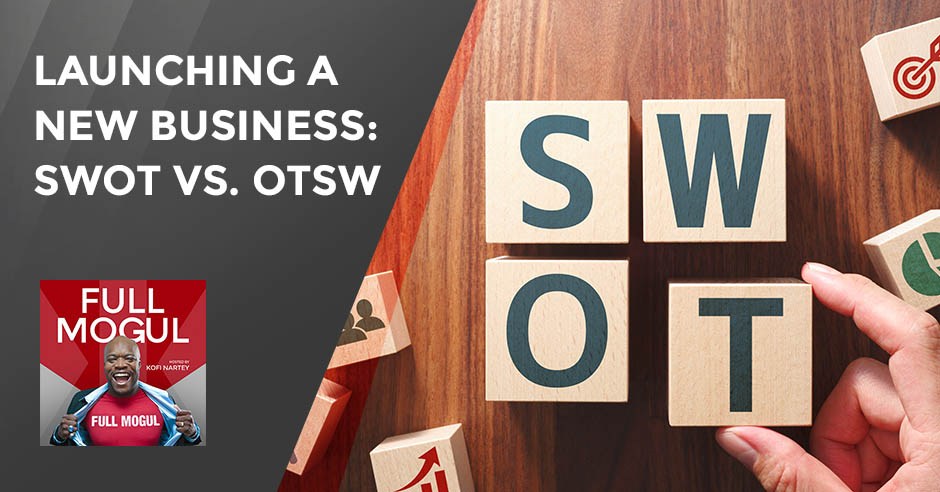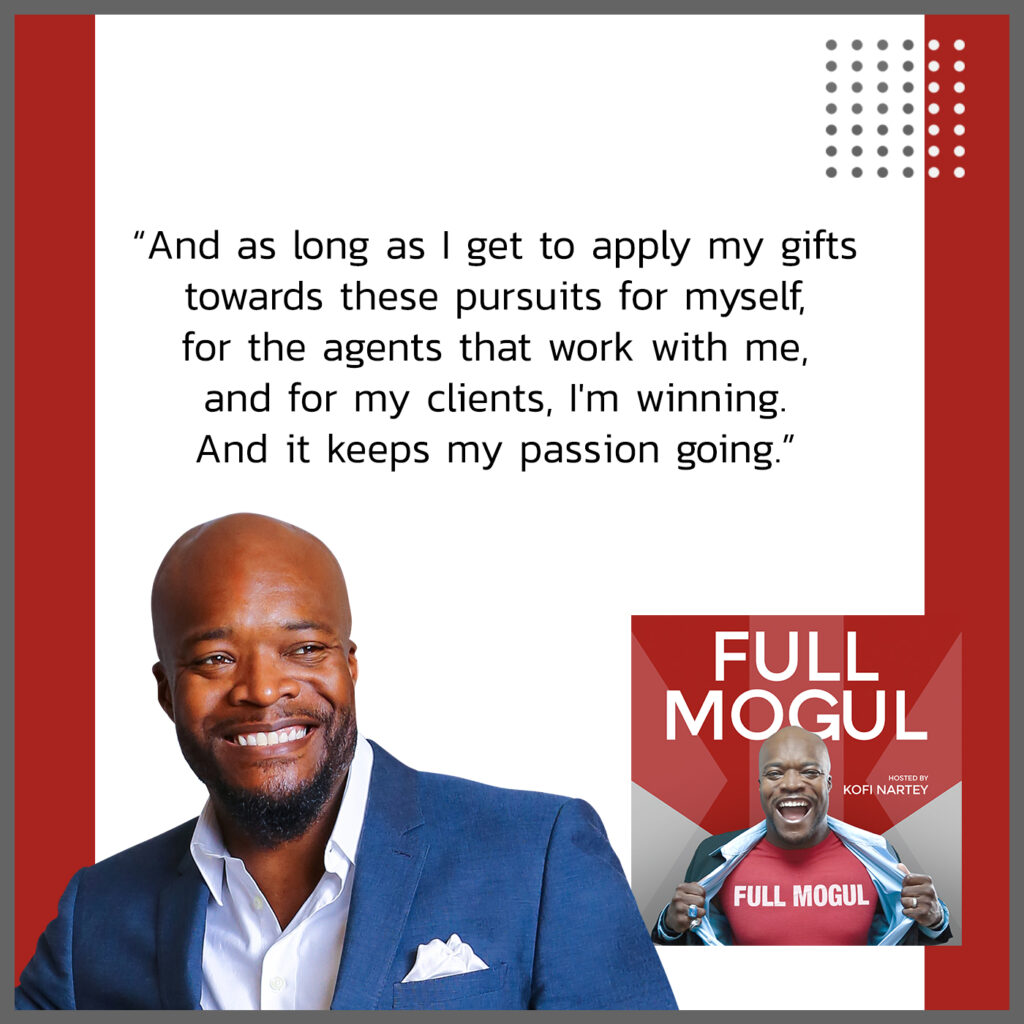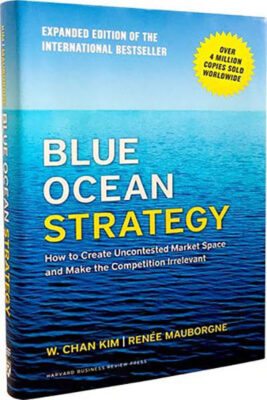
Are you considering launching a new business or adding a new product or service to your existing business? If yes, then you MUST listen to this podcast first. We will discuss the problem with a traditional SWOT Analysis, as well as the importance of TAM and PMF. Learn how to embrace one good opportunity that will bring you rewarding results and help bridge gaps in the marketplace – even if it will not be your life-long venture.
—
Listen to the podcast here
Launching A New Business: SWOT vs. OTSW
The Most Important Podcast You Can Listen To Before Launching A New Business
I’m super excited to have you back on this Full Mogul journey, which is the relentless pursuit of the best version of yourself across all aspects of your life. You are on the Full Mogul journey with me. I’m excited to be a part of your journey. Hopefully, it’s been helpful. This is going to be one of my favorite episodes so far. It’s going to be a quick one but a critical one. The title of this episode is Launching A New Business, SWOT versus OTSW. This may be the most important episode you are going to read before launching a new business or adding a new product or service to your business.
I know a lot of you guys out there are entrepreneurs. A lot of you are in the real estate industry like I am, investors and financial planners and there are a lot of athletes out there but all of us have those moments where we’re going to launch something new. There’s been a spark in us that tells us we have the talent, gift and idea that we want to bring to the world. If we’re going to do something like this, there’s a little bit of analysis that immediately comes into play.
What Is SWOT?
Let’s start at the beginning. What is SWOT? Let’s define SWOT because this applies to whether you’re launching a new business, adding an arm or service to your business, a new partnership in your business and anything that is going to be different from what you’re doing in terms of starting from scratch, adding on, in addition to, will do something similar to a SWOT analysis. It’s an old-school business term.
It still comes up from time to time but SWOT stands for Strengths, Weaknesses, Opportunities and Threats. This is a term that’s used in business school training. It’s evolved quite a bit. We look at something called the total addressable market. You can google that. It’s another version of a SWOT analysis. It’s the total addressable market that you’ll have for your product or service. Take a read at that as well.
For this episode’s purposes, we’re going to stick with SWOT because it ties into re-engineering those letters into what I described as OTSW. Starting with the idea, “I’m good at something. I’ve created something cool so I want to make a business out of it. I want to create a service, company, storefront or online store but is there a market for it?” Let’s jump right into that.
There are some benefits of SWOT. If we even break it down, it is Strengths, Weaknesses, Opportunities and Threats. What are the strengths that you have? Normally, that’s the easiest thing to identify because the idea, concept, theory and service were born out of strength. That gift that you have gave you that creative spark to say, “I’m going to turn this into a business.” It’s not too hard to identify the strengths. Weaknesses are a little bit harder to identify but some of them are blind spots.
Also, you look at the business you want to get into or start and there might be some glaring weaknesses like licensing or a location that you need and a certain skillset that you don’t have. Those are all weaknesses that will be part of your analysis as to whether or not this is a viable thing to pursue. What opportunities exist in the marketplace for this service, product and strength that you’re bringing? Is there a TAM or Total Addressable Market? How big is that marketplace? Those are also something that has to be addressed.
The T is for Threats. What are the threats to the business or idea that you have? Who’s the competition for the business or idea that you have? When we look at the competition, we have to look at it beyond who’s doing what you’re doing in the marketplace. Just because there’s somebody who’s doing it, doesn’t mean that you can’t do it too and you can’t do it better.
Just because somebody is doing something doesn’t mean you can’t do it too or do it better. Share on XSometimes that lets you know that there’s an addressable market for it. If that company is already thriving but there’s no competition and they’re not dominating the market, they’re doing well, that might be an indication that with that threat or particular competitor, there’s room to take them down or gain market share that they don’t have access to or you can claw away from them.
There’s also the threat of technology. A lot of times businesses don’t think that they can be undercut by technology. You think of simple things like the Polaroid camera but then we went to digital. People got rid of the film. Kodak lost a lot of money because they created film then we went to digital and SIM cards. Everything’s in the cloud. These are technological threats to select business models. Almost every industry, service and product needs to consider technological threats.
“Can AI or Artificial Intelligence replace what you’re doing? Can a computer do it much faster and more efficiently? When people turn to that before they turn to you, what is your value add?” These are all threats. Coming back to the overall SWOT analysis, it can be a great filter to run your idea through, “What are my strengths? What are the weaknesses that I need to make up for or mitigate? What are the opportunities in the marketplace? What are the threats as well?” The challenge with this is if you start and lead with just your strengths and bull rush or move forward into a market, into what is “opportunity,” you may fall flat on your face. I’m going to tell you why.
What Is OTSW?
Let’s reverse-engineer those letters. It’s not exactly backward but we’re reverse-engineering it. For the acronym’s sake, we’re going to call it OTSW. The reason that I full-heartedly believe in OTSW and why I’ve leaned into this concept is because you have to start with the opportunity in a marketplace. Where does the opportunity lie? What is not being serviced to the level or the extent that the consumer wants, needs or would appreciate if it occurs? That’s where the opportunity lies.
We have to start with where the opportunity is. We look at the threats and then next to the strengths. We look at our strengths, the strengths of our product, service and skillset or whatever we’re harnessing, putting together for this new venture. “What are the strengths that me, my service or my product has to fill that opportunity?”

New Business: Look at your strengths, as well as the strengths of your offers and skill sets, when putting together a new venture that can fill a market opportunity.
When we look at overall business success, the overall wealth that can be created, the overall size of a business and growth and scale, it’s where the quality meets the quantity. The quality of the service that you’re providing, the need for that service and the quantity at which you can provide it. It’s that scale at which you can provide it.
You look at things like Amazon. It has a great quality of service and a huge scale in terms of the market. Even Starbucks. The coffee is pretty good. You might like Coffee Bean better, your local Blue Bottle or whatever coffee shop you go to in your neighborhood. There’s a huge addressable market, the efficiency of that. Other things tie into Starbucks like the brand. They’ve created a great brand for themselves, a culture of being tied to Starbucks but there’s a huge addressable market and then they applied their strengths to that market.
I did mention at the top that SWOT has been replaced with product market fit and that’s the degree to which your product satisfies strong market demand. This is something about Marc Andreessen, a famous entrepreneur. Google him if you haven’t read about him. There is a lot to learn there but he coined this phrase back in 2007. We look at that product market fit, the opportunities in the marketplace and what strengths we have to fill them.
Real-Life Examples
I’ll give you a couple of real-life examples. I got into real estate in 2003. I got my broker’s license in 2006. It’s been rocking and rolling ever since. It’s been a huge learning curve since the beginning. I feel like I’m a 5th-degree black belt but still have more stripes to add to my belt. There’s always something new to learn. When I got into real estate, I quickly realized that it was a huge market. There was total demand for the market but you also had to have a specialization or a niche within the market.
Real estate is a huge market. Despite having high demand, you must have a specialization or niche within it. Share on XThere were so many real estate agents in 2003. Everybody I knew was either doing something in real estate or acting in LA. Here I am, I was doing both. I was an actor and a real estate agent so I needed to have a focus. I initially focused on condos and townhomes but I’m going to fast forward to when I transitioned into luxury real estate, more specifically sports and entertainment as a niche.
I looked at the opportunities, threats and competition but I also first recognized that there was a void in servicing sports and entertainment clients in understanding their lifestyle, the ebbs and flows of income, the need for privacy or security, the quick transitions that they often have to make, the traveling for work, the doing a $2 billion movie 1 year and not working for 3 years but you have the funds to get financed.
Lenders understand that there were all these nuanced differences in working with this type of clientele. I was in the heart of the entertainment industry here in LA. I had been part of the industry and sports world with my sports experience at Berkeley with my shot at the NFL with the Raiders. I had seen all of these aspects and nuances of this specific clientele. I saw that it was under service and no one owned that niche or specialized in it. That’s where the opportunity was.
I looked at my strengths to apply. I had exposure to the niche and an understanding of their lifestyle. I knew a lot about real estate at that time. I had my broker’s license. I had already been managing other people so I had a lot of contractual experience. I was good in my field and now I was going to take it to another level of specialization to service that market that was underserviced where there was a huge opportunity.
I’ve seen agents because I’ve built a great national brand with that. I get to speak around the country. It’s a blessing to do and share that. A lot of agents want to get into sports and entertainment. The first thing I ask them is, “Is there a marketplace for it? Is there an opportunity?” They’ll say, “John Elway lives down the street from me and I’d love to get his business.” “It’s John Elway’s third home in an area of Texas where he likes to fish.” There are no other sports teams or celebrities. I’m just making up this example.
You have to make sure that the opportunity is there. I’ve seen it with entrepreneurs whom we’ve given guidance to. I’ve given advisory services to help them with creating their brand, idea and strategy but they create an amazing widget or they’re a technopreneur or an engineer. They’re great at computer science. They can create an amazing backend and they feel great about their product but there isn’t truly an addressable market. There isn’t an opportunity that is truly scalable for what they’ve built.
Sometimes there is and there are other aspects that are missing like the right marketing strategy, packaging, branding and messaging, what type of marketing you’re going to use and the name of your product. We’ll get into some of that other stuff later. The first thing is to take that because we are entrepreneurs.
Moguls tend to be entrepreneurs. We’re not going to deny the fact that it often starts with strength and sparks an idea but then we take that idea before we launch or move forward and we hold it up against OTSW. “What are the opportunities? Where does the opportunity lie? Where is the total addressable market? How big is that total addressable market? What is that product market fit? What are the threats to it? What are my strengths in service and bringing this to the marketplace in a unique way or a Blue Ocean Strategy way that I’m creating in a non-competitive space because what I’m doing is nuanced and different enough that I can excel without competition or at least get a huge head start on my competition in this industry?” We then finally move forward.
We are looking at the W, the Weaknesses and what gaps we need to fill. What things do we need to put in place to increase our chances of major success? Another great book to read is Blue Ocean Strategy. It’s by Chan Kim and Renee Mauborgne. I read it in business school. I have reread it 2 or 3 times. It’s another great book recommendation.
That blue ocean is defined as the simultaneous pursuit of differentiation and low cost to open up a new market space and create new demand. That’s how they defined it in the book. It’s about capturing the uncontested marketplace, the market space that doesn’t have the same level as the red ocean, which is all the sharks, blood and where everybody is competing. That way, if you go to the blue ocean, you’re making that competition irrelevant. You always got to move and swim towards the blue ocean, looking towards that ocean, where the O or Opportunities lie and where your strengths have the greatest chance of success.
Questioning Yourself
It comes back to questions. I have people say, “Does this limit me to doing things that fill gaps in the marketplace? Do I have to start by looking for those gaps in the marketplace? What if I’m not passionate about filling those voids? What if I want to do my thing?” You’re an entrepreneur, which means you have to think through this process. You may have 1, 2, 3 or 4 gifts. I know you do. You have to look at which gift has the largest opportunity to help you reach the highest and best version of yourself as a Full Mogul.
You also have to realize that this is not always a lifetime commitment but it’s something that you owe yourself to exercise that opportunity and that gift, take it to its highest level of potential where what you have achieved and the ultimate potential of that gift are staring each other eye to eye, then you can move on to the next thing.
Part of that process is whatever strength you’ve identified running it through OTSW. It has to be something that you do have a genuine passion for. You shouldn’t do something that you dislike. You do have to do something that you have passion about but it doesn’t necessarily have to be your life’s work or the thing you’re going to do for the next 30, 40 or 50 years. You might do it for 5 to 10 years and say, “I’m liking this. I’ve scaled. I’m going to do it for ten more.”
I’ve been in real estate for many years. There’s a natural progression to how I’ve built my business, growing from just being an agent, to then being a broker, being an assistant manager, launching offices, building my team, specializing in sports and entertainment, building a national brand, expanding into new development, having my firm and residential agents that I support their growth. We have a new development team and investment arm. That has allowed me to add chapter after chapter to a book that continues to be interesting to me.
Some people reach a certain point and need to change industries. Think of what you’re applying your gift to, this product, service, idea, additional arm to your business and this new service you want to launch. You’ve run it through the filter. You’re going to do it. It may not be your life’s work forever but it can be an amazing chapter in your book.

Sometimes, it’s a new book. Don’t be afraid to say, “The chapters of that particular book are done. It’s time for me to write a new book with new chapters and a new vision for my life.” It might start with this amazing new idea that you have. The process, outcome or impact is going to be based on the passion that you have that gets you up every day, moving towards this success that you have calculated based on switching SWOT to OTSW.
I’ll give you one Kofism before we conclude here. Kofism is my life philosophy, “None of us were born to do what we are doing. The more we can overlay our gifts, passions, hard skills and soft skills, the more we will find alignment with what we’re doing and joy in what we’re doing.” Here’s a personal example. Was I born to do real estate? I don’t think so. Could I apply my gifts to other things? Definitely.
I found so much alignment in this career with things that I’m passionate about, good at and like to do, everything from marketing to creativity, business strategy, negotiations, working with people and loving properties, architecture and building a real estate firm. Also, aspects of development, new development and the investment that can build generational wealth for myself and my clients. That’s a lot. As long as I get to apply my gifts toward these pursuits for myself for the agents that work with me and my clients, I’m winning. It keeps my passion going.
In conclusion, SWOT versus OTSW before launching a new business, adding a new product or service to your line of business, company or store, try to find the biggest, most lucrative or scalable and self-fulfilling gap in the marketplace that you can fill. With that, this concludes this episode. I hope you enjoyed this. Please share. If you want to add to the story of SWOT versus OTSW, product market fit and total addressable market, please ping me. Find me on Instagram, @Kofi_Celebrity. Ping me on the website, FullMogul.com. I love to hear from you and your feedback. Let’s keep going on this Full Mogul journey together. Take care. Bye.
Important Links
- Blue Ocean Strategy
- @Kofi_Celebrity – Instagram
